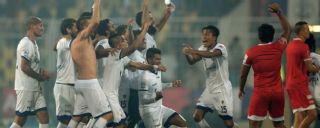|
There is an inherent dichotomy about the Indian Super League (ISL) that makes it impossible to reconcile to for an objective observer. ISL began its first season two years ago with a glitzy marketing campaign -- indeed, the tagline "the birth of a footballing nation" was remarkable both in its audacity and its ignorance of India's rich history in the sport -- but grew over the subsequent months to being counted as the fourth most-watched league in the world, after England, Germany and Spain. The first season's final was played in Navi Mumbai's DY Patil Stadium, a venue that had also hosted the first final of cricket's Indian Premier League (IPL) in 2008, and was billed as a clash between the co-owners of the finalists, former Indian cricket teammates Sachin Tendulkar and Sourav Ganguly. Yet, it was the football that held centre-stage the first season, despite the tepid statistic of just 129 goals in 61 matches. The drama, especially when it came to qualifying for the playoffs, was gripping and the final was decided by a late winner. In the second year, the organisers promised a better quality of play, and ensured there were younger players signed by the teams. Four out of the marquees in the first year were FIFA World Cup winners, with the rest having had an experience of playing in the knockout stages. Those regulations were relaxed to a great extent in 2015 -- though the real reason might have had more to do with budgetary limitations -- as the concept of marquee player-manager was embraced by two clubs as opposed to one the previous year. The number of goals increased dramatically -- by the end of the league stages alone, there were 171 goals, as compared to 121 from 56 games in 2014. This year, an 'active marquee' rule has forced the clubs to become even more conservative with their big-name signings. The All-India Football Federation (AIFF) has suggested a domestic football structure wherein the ISL will become a longer league and have more teams in the coming years. Their idea, revealed in May, suggests dropping the official league of the country, the I-League, to a secondary status, and currently has no provision for promotion and relegation. This is a direct contravention of the Article 6.1 of the Asian Football Confederation (AFC) which clearly states that "The entitlement of a club to participate in a domestic league championship shall depend principally on sporting merit. A club shall qualify to participate in a domestic league championship by remaining in a certain division or by being promoted or relegated to another at the end of a season." Yet, the ISL has the backing of the AFC, whose president recently suggested that the merger of ISL and I-League ought to be the way ahead. On Wednesday, the AFC's general secretary Dato' Windsor John even said that "the AFC is happy to give support and advice but the important decisions on the format of the proposed new league are purely the domain of the AIFF." The whys and the hows are still a matter of debate, but it is without doubt that the ISL touches a chord with football fans, possibly also down to the fact that unlike the I-League, it takes the game to cities and centres outside of the traditional Indian football strongholds of Kolkata and Goa. Never mind the fact that just like the last two years, the Indian national team's international calendar will come to a near standstill, and that the reigning I-League champions are one clean sheet away from scripting history as the first Indian team to reach the AFC Cup final. This will mean that all ISL franchises except FC Goa will miss their Bengaluru FC players for at least the first three weeks of the tournament, with Mumbai City FC and Kerala Blasters affected the most. Let these distractions not take away from the entertainment on offer, though. ISL into its third season would be expected to serve up some bigger contests and sub-plots. Many of the foreign players and coaches are into their third season and needless to say, would be a lot better used to both the conditions and the rigorous schedule that teams have to go through in these two months and a bit. 2015 saw as many as eight hat-tricks, with two Indians joining in the party. Goa have perhaps led the way, but gradually all teams have started playing all of the mandatory five Indian players in the starting lineup in key positions. There are as many as 34 nationalities involved encompassing the eight teams and their coaches, each bringing with them a distinct philosophy and a unique flavour to the ISL. Two of the clubs, Atletico de Kolkata and Mumbai City FC, will be playing in new grounds which might be smaller in relative size, but are both located closer to the centre of the city and hence would be expected to create an atmosphere befitting the occasion. The ISL has also come to mean a lot to the players involved -- particularly with only 40 Indian players effectively fighting out for first-team starts, the commitment to stay fit and focused cannot be overemphasised. For the foreign players, there's the small matter of having the opportunity to showcase their skills in one of the world's fastest-growing football economies. This is vital, because this places not just the younger players in focus, but also ensures those retired recently and those taking their first steps as professional coaches and managers have lots to gain from having a good season. The lines are drawn; the ball is just by the centre-line. Prepare yourselves for what should be a thrilling ride. ISL: Full coverage Scores | Fixtures | Table Team previews Atletico de Kolkata Chennaiyin FC Delhi Dynamos FC Goa FC Pune City Kerala Blasters Mumbai City FC NorthEast United FC
|

